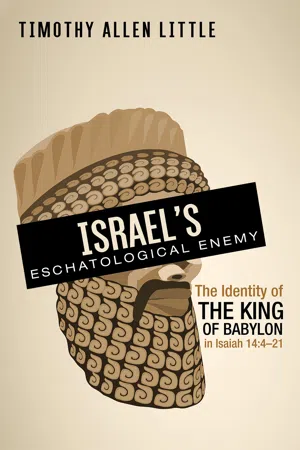
Israel's Eschatological Enemy
The Identity of the King of Babylon in Isaiah 14:4–21
- 200 pages
- English
- ePUB (mobile friendly)
- Available on iOS & Android
Israel's Eschatological Enemy
The Identity of the King of Babylon in Isaiah 14:4–21
About This Book
Who is the king of Babylon in Isaiah 14? The early church sometimes identified him as Nebuchadnezzar, but most also saw a deeper meaning in Isa 14:12-14, believing this section referred to Satan. Many current scholars reject both views and offer a variety of alternatives. Little argues that "shining one" (Lucifer) in Isa 14:12 is the king of Babylon. This book analyzes the mashal (proverb) genre and argues that the Isa 14 mashal must be a real person, not a symbolic, ideal, eclectic, or representative king. Scholars have presented nine historic kings as the king of Babylon. Little compiles a list of fifteen criteria from Isa 13-14, evaluates these nine kings, and demonstrates that no historic king comes close to fulfilling the fifteen criteria. Instead, Little argues that the king of Babylon is Israel's eschatological enemy. Through the use of catchwords and temporal particles, he first demonstrates that the oracle is a unit. Then he proves that this Babylonian judgment is eschatological. All foreign languages have been translated, allowing the student of prophecy and theology to benefit from this work. Those interested in the mashal genre, Hebrew poetry, and Isaianic exegesis will also find this book stimulating.
Frequently asked questions
Information
Introduction
Table of contents
- Title Page
- List of Tables
- Acknowledgments
- Abbreviations
- Chapter 1: Introduction
- Chapter 2: The Genre of Isaiah 14
- Chapter 3: The Massa’ against Babylon—Isaiah 13:2—14:2
- Chapter 4: The King of Babylon
- Chapter 5; Conclusion
- Appendix 1
- Bibliography